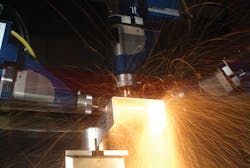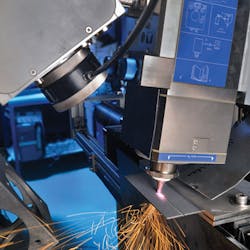Lightweight construction concepts have become an indispensable part of today's production technology. The automobile industry, for example, uses press-hardened and ultra-high strength steels with tensile strength up to 2000MPa in car body construction to reduce weight. Compared to steels with lower strength, these high-performance steels allow smaller sheet thicknesses that lead to lighter components, which in addition exhibit equally good or even improved crash behavior. To process these demanding high-performance materials, laser processing is the method of choice. Together with project partners from science and industry, scientists from the Fraunhofer Institute for Laser Technology (ILT; Aachen, Germany) have advanced the development in separation and joining as well as heat treatment technologies.
Sheets made of ultra-high strength steels are commonly used for B-pillars or side-door sills of passenger cars, where an extremely high absorption of kinetic energy is a key issue in the event of an impact. However, the high strength of these materials makes it necessary to adjust the processing methods, such as cutting and joining. Conventional mechanical cutting and joining processes, such as stamping, clinching, or riveting, cannot be used at a reasonable expense. As an alternative, laser light has proven its value as a processing method in industrial applications. Laser cutting has already proven itself many times as a separation process, while joining is essentially achieved by spot welding. Both methods, however, lead to metallurgical effects that can adversely affect the component properties. During cutting, hardening occurs in the edge zone of the cut edge—in the case of spot welding, a heat-affected zone forms with a distinct hardening reduction around the welding spot. These two effects lead, in the worst case, to the failure of the joint and thus, in the case of damage, to a reduced absorption of the kinetic energy in the component. By means of local laser heat treatment in the cutting edge region and in the joining zones, this weakening can be counteracted. The hardness and ductility of the material can thus be adjusted locally to tensile elongations of 10–15%.
Joining ultra-high strength materials requires a low energy per unit length. This can be achieved with laser welding at 20–80kJ/m. For thin plates of chromium steels with martensitic microstructure and tempering steels, Fraunhofer ILT has developed suitable fusion welding parameters. Twinning-induced plasticity (TWIP) steels containing high manganese content have also been successfully joined by laser welding in joints with the same as well as with dissimilar materials. A loss of the strength was countered here by a suitable load control.
Recognizing that it makes sense to combine individual process steps in one tool for economic reasons, a collaboration project called KLASSE—sponsored by the German Federal Ministry of Education and Research (BMBF; Bonn, Germany) and being carried out by Fraunhofer ILT along with partners from the automotive industry and laser plant construction—has resulted in a combination processing head with a hybrid laser beam source consisting of a diode laser for heat treatment and a fiber laser for cutting. For several years now, a laser processing head developed by Fraunhofer ILT and marketed by Laserfact (also in Aachen) has been used in the industry, combining different work steps. The head incorporates cutting and welding process steps into one machine without a need for retooling. In spring 2016, a powder nozzle was integrated, enabling it to carry out additive manufacturing steps by means of laser metal deposition (FIGURE 1). Thanks to this integration, setup times can be minimized and highly flexible production made even more efficient. In addition, the head can also be used to cut composite materials such as carbon-fiber reinforced components, which are becoming increasingly popular in car body manufacturing because of their low weight and excellent mechanical properties.
After cold-rolling, cold-strengthened steels are generally subjected to overall recrystallization annealing. In the cold-strengthened state, the thickness of the steel sheets can be reduced, but the material can only be deformed to a lesser degree, and its ability to absorb energy in the event of a crash is reduced significantly. A local heat treatment can improve the crash properties of the components (for example, controlled folding of a crash box) by introducing soft zones into it. In sheet-metal plates made of low-alloy steels, a combination of cold rolling and local laser heat treatment (FIGURE 2) prevents cracks from occurring in the subsequent forming process at particularly stressed areas, typically at the edges of shaped components.
The Local Laser Heat Treatment of Cold Strengthened Steels for Improvement of Forming and Functional Characteristics (LAKS) project, funded by the German Federation of Industrial Research Associations (AiF) and carried out at Fraunhofer ILT and the Metal Forming Institute (IBF) at RWTH Aachen University, is first determining correlations between the temperature-time profiles and the resulting properties and mechanical properties through parameter tests. The project team will subsequently carry out deformation tests and crash tests, with the latter to be validated in forming tests under quasi-static as well as under sudden loads. In future development steps, the project team will investigate corrosion properties, simulate the deformation in production and operation, and arrange the process into the production process optimally.
For more information, please visit www.ilt.fraunhofer.de.


